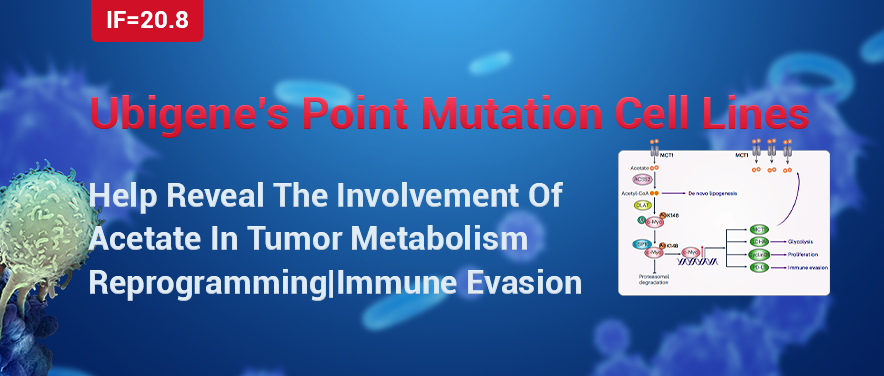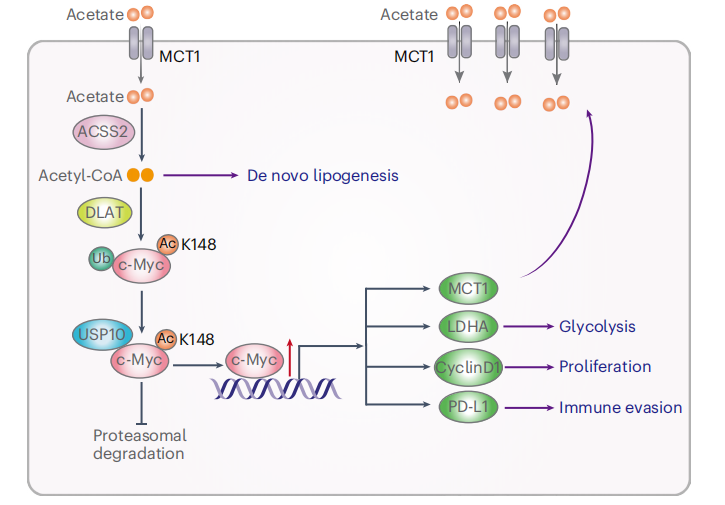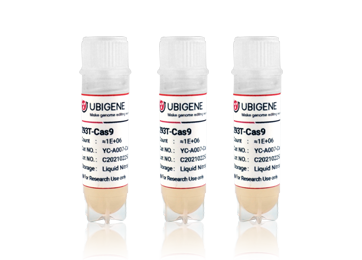IF=20.8|Ubigene's
Point Mutation Cell Lines Help Reveal The Involvement Of
Acetate In Tumor Metabolism Reprogramming And New Mechanisms of Immune
Evasion

Acetate is a precursor of acetyl-CoA, playing a crucial role in
energy production, lipid synthesis, and protein acetylation. However, it is unknown whether acetate reprograms
tumor
metabolism and contributes to immune evasion in cancer.
Recently, researchers from Zhejiang University and the Chinese
Academy of Medical Sciences and Peking Union Medical College, led by Zhimin Lu and
Jie He,
published a research paper titled “Acetate reprogrammes tumour metabolism and promotes PD-L1 expression and
immune
evasion by upregulating c-Myc” on Nature Metabolism (IF: 20.8). This study
demonstrated that acetate is the most abundant short-chain fatty acid in human non-small cell lung cancer
tissue,
with increased acetate uptake as the tumors enriched. The study used Ubigene-constructed MYC (p.K148R) point
mutant A549
cells and MYC (p.K148Q) point mutant A549 cells, simulating acetylated and
non-acetylated c-Myc
states, and investigated the impact of these changes on tumor cell behavior.
Acetyl-CoA derived from acetate induces c-Myc acetylation,
mediated by the moonlighting function of the metabolic enzyme dihydrolipoamide S-acetyltransferase. To
comprehensively understand the function and mechanism of c-Myc acetylation, MYC
(p.K148R) A549 cells and MYC (p.K148Q) A549 cells constructed by
Ubigene were used to simulate the acetylated and non-acetylated states of
c-Myc,
investigating the impact of these changes on tumor cell behavior. The research found that acetylated c-Myc
increased
its stability and subsequently encoded the transcription of genes for PD-L1, glycolytic enzymes, monocarboxylate
transporter 1, and cell cycle accelerators. Dietary supplementation of acetate can promote tumor growth and
inhibit
CD8+ T cell infiltration, while disrupting acetate uptake can inhibit immune evasion,
thus
improving the efficacy of anti-PD-1 therapy.
Acetate in the blood circulation can be derived from the diet (such
as dairy, processed meat and bread, ethanol, and indigestible carbohydrates), the breakdown of dietary fiber by
gut
microbiota, and acetylated metabolites within the body. Acetate concentrations in human plasma range from 50 μM
to
200 μM, and can exceed 800 μM in the plasma of chronic drinkers. Acetate serves as a biological substrate in
human
tumors. Positron emission tomography (PET) imaging studies using 11C-acetate have shown that
prostate,
lung, liver, and brain tumor patients exhibit significant acetate uptake, which has advantages in accuracy and
sensitivity compared to 18F-fluorodeoxyglucose PET imaging.
In 13C-acetate metabolic tracer studies promoted by
nuclear magnetic resonance, patients with glioblastoma, breast cancer, and non-small cell lung cancer (NSCLC)
infused with 13C-acetate during surgical resection displayed robust acetate oxidation dependent on
acetyl-CoA synthetase 2 (ACSS2), which converts acetate and CoA to acetyl-CoA. Additionally, ACSS2 plays an
important role in acetate-dependent lipogenesis, histone acetylation, and maintenance of tumor cell growth under
metabolic stress. Although acetate has been extensively studied as an energy source and a regulator of gene
expression dependent on histone modification, it is still unclear whether it directly regulates oncogenic
proteins
to mediate tumor growth.
This study demonstrated that NSCLC cells uptake acetate in a manner
dependent on Monocarboxylate Transporter 1 (MCT1). Acetyl-CoA derived from acetate and produced through ACSS
induces
acetylation of c-Myc lysine 148 mediated by dihydrolipoamide S-acetyltransferase (DLAT), recruiting
ubiquitin-specific peptidase 10 (USP10) to deubiquitinate and stabilize c-Myc, leading to enhanced programmed
death-ligand 1 (PD-L1) expression and promoting tumor immune evasion, as well as the expression of glycolytic
and
cell cycle progression genes to accelerate cell proliferation.

Figure 1 Mechanism pattern
diagram
In summary, these findings emphasize the key role of acetate in
promoting tumor growth, not only as a metabolic carbon source, but also through reprogramming tumor metabolism
and
immune evasion. These findings also highlight the potential of controlling acetate metabolism to inhibit tumor
growth and improve the response to immune checkpoint blockade therapy.
Ubigene's gene
point mutation cell
construction service can easily
solve problems such as tricky mutation sites, low transfection efficiency, and poor single clone
formation rate.
Through Ubigene's exclusive CRISPR-U™ technology, automatic mutation strategy design system, 4 solution
methods
(e.g. RNP), altogether contributes to the editing efficiency increased by 10 fold, unfazed by tricky
mutation sites!
Now, point mutation service enjoiys new promotion, delivered in as fast as 10 weeks for homozygous
clones. Come and
inquire about the promotional price!








